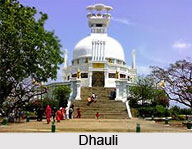 Tourism in Bhubaneshwar expresses the rich temple history of ancient and medieval era especially during the era of Chodaganga Dynasty of East India. Bhubaneswar, the capital of Odisha, is also popularly known as the "Temple City of India".
Tourism in Bhubaneshwar expresses the rich temple history of ancient and medieval era especially during the era of Chodaganga Dynasty of East India. Bhubaneswar, the capital of Odisha, is also popularly known as the "Temple City of India".
Bhubaneswar, the capital of Odisha, is also popularly known as the "Temple City of India". Being the seat of Tribhubaneswar or "Lord Lingaraj", Bhubaneswara is an important Hindu pilgrimage centre. There is hundreds of temples that dot the landscape of the Old Town, which once boasted of more than 2000 temples. Bhubaneswar is the place where temple building activities of Orissan style flowered from its very inception to its fullest culmination extending over a period of over one thousand years. Bhubaneswar with its modern buildings and extensive infrastructure perfectly complements its historic surroundings. With facilities to cater to every type of visitor, Bhubaneswar makes an ideal tourist destination.
Dhauli or Dhabalgiri
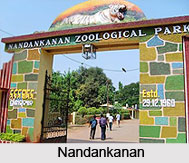 Surrounded by paddy fields, the Dhauli hill brings back memories of the historic `Kalinga war` which was fought around here. It is here that Ashoka, the terrible, was transformed into Ashoka, the compassionate and championed the cause of Buddhism. On the foot of the hill one can see the Rock Edicts of Ashoka and the forepart of a skillfully sculpted elephant hewn out of a huge rock. Dhauli has gained prominence due to the establishment of a Buddhist Peace Pagoda, popularly known as Shanti Stupa, built in the early seventies by the Japan Buddha Sangha and Kalinga Nippon Buddha Sangha. An old temple of Lord Dhavaleswar, reconstructed in 1972, also stands on the hill-top.
Surrounded by paddy fields, the Dhauli hill brings back memories of the historic `Kalinga war` which was fought around here. It is here that Ashoka, the terrible, was transformed into Ashoka, the compassionate and championed the cause of Buddhism. On the foot of the hill one can see the Rock Edicts of Ashoka and the forepart of a skillfully sculpted elephant hewn out of a huge rock. Dhauli has gained prominence due to the establishment of a Buddhist Peace Pagoda, popularly known as Shanti Stupa, built in the early seventies by the Japan Buddha Sangha and Kalinga Nippon Buddha Sangha. An old temple of Lord Dhavaleswar, reconstructed in 1972, also stands on the hill-top.
Nandankanan Zoological Park
Picturesquely carved out of the Chandaka forest, Nandankanan is a Biological Park where animals are kept in their natural habitat. A centrally located lake divides the Zoo from the Botanical Gardens. Tigers, Lions, Clouded Leopards, Black Panthers, European Brown Bear, Himalayan Black Bear, Gharials, Rosy Pelican, Grey Pelican, Indian Python, King Cobra, etc. are among the attractions of the zoo, which is famous for its White Tigers. The exotic Botanical Garden on the other side of the zoo preserves varieties of indigenous plants. Regular bus services are available to reach the place.
Bindu-Sarovara Tank
It is said that Lord Shiva established this tank as a place of pilgrimage by bringing water from all the holy places.
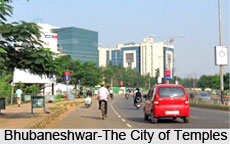 Taking bath here and drinking the water of this lake is said to cure any disease of the stomach. Lord Chaitanya took bath in this lake when He first came from Bengal to Puri. It is located right next to the Lingaraja Temple . A pilgrimage to Bhubaneswar is supposed to start with a bath here. On the eastern bank is the `Ananta Vasudeva` temple , which is dedicated to Krishna and Balarama.The Lingaraja deity is brought to the pavilion in the middle of the tank and ritually bathed during the annual Car festival (`Ashokastami `). The best time to come here is around sunrise.
Taking bath here and drinking the water of this lake is said to cure any disease of the stomach. Lord Chaitanya took bath in this lake when He first came from Bengal to Puri. It is located right next to the Lingaraja Temple . A pilgrimage to Bhubaneswar is supposed to start with a bath here. On the eastern bank is the `Ananta Vasudeva` temple , which is dedicated to Krishna and Balarama.The Lingaraja deity is brought to the pavilion in the middle of the tank and ritually bathed during the annual Car festival (`Ashokastami `). The best time to come here is around sunrise.
Lingaraja Temple
The Lingaraja temple dominates the skyline of Bhubaneshwar from as far away as 15-kms and exhibits the skill of the Orissan temple architects at its completely mature and developed stage. This temple was constructed in the 11th Century AD at the site of an old 7th Century Shrine. Along with the `deul` and the `Jagmohana` the Lingaraja temple has two new structures, the `Nata Mandira` (dance hall) and the ` Bhoga Mandapa` (offering hall). Dedicated to Lord Shiva the `Lingam` here is unique in that it is a `Hari Hara` lingam - half Shiva and Half Lord Vishnu. There are around 150 subsidiary shrines within this giant temple.
Muktesvara Temple
Often referred to as the `Gem of Orissan Architecture` this temple has been built on the lines of the Kalinga School of temple architecture. This temple too is a deviation in that the architects have blended old and new techniques of planning and execution. Many new innovations in later temples are from here. A `Torana`, an arched gateway is a unique feature of this temple. The temple dedicated Lord Shiva-Mukteswara , is carved with figures of ascetics in various poses of meditation and scenes from the storehouse of Indian fables, the `Panchatantra`. A dip in a sacred well to the east of the temple is supposedly a cure for infertility.
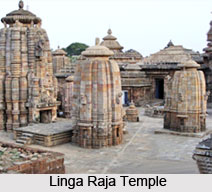
Parasurameswara Temple
Parasurameswara Temple built in 650 AD is one of the few earliest temples of Bhubaneshwar. This temple built in the `Kalinga` style of temple architecture was dedicated to Lord Siva but there are images of Lord Vishnu, `Yama`, `Surya` and seven Mother Goddesses. In typical fashion, it is liberally sculpted with amorous couples, animals and floral motifs.
Just south of Parasurameswara temple is the `Swaranajaleswara` temple is the `Swaranajaleswara` temple. Built in a similar style, the motifs on the walls however differ, depicting scenes from the `Ramayana`.
Raj Rani Temple
The Raja Rani temple is an essay in grace and poise and is particularly interesting in that it has no presiding deity. The name of this temple is supposed to be derived from the red-gold sandstone used - Raja Rani being the local name for the stone. The `deul` is intricately carved with figurines in various stages of daily chores. The lower portion of the deul has the `Gurdians of the eight directions` guarding the eight cardinal points of the temple.
Brahmeshwara Temple
Brahmeswara temple depicts the mature Orissan style of temple architecture. The `deul` and the `Jagmohana` are both intricately carved and for the first time in temple architectural history musicians and dancers appear on the outer walls and iron beams find their first use. In the western section `Chamunda`, Shiva and other deities are depicted.
Vaital Deul Temple
Vaital Deul is the Shrineof `Chamunda` or `Shakti`. Seated on a corpse in a dark inner sanctum is the Goddess Chamunda, garland of skulls round her neck and flanked by a jackal and an owl. The niches on the inner wall depict equally startling images along with scenes of tantric rituals. It is the first of the temples to depict erotic sculptures, it is also unique in that the outer surface of the vault is plain while profusely embellished on the inside.
Mohini Temple
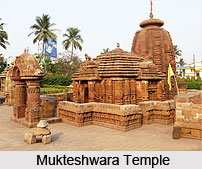 Standing to a height of about 9.45m. On the south-bank of Bindu-Sarovara, it is, in its architectural features, a close analogue to the Parasuramesvara temple . Its carvings, however, were left unfinished. The damaged jagamohana has been restored recently. All the images of Parsva-Devatas- Parvati, Kartikeya and Ganesa- are in situ.
Standing to a height of about 9.45m. On the south-bank of Bindu-Sarovara, it is, in its architectural features, a close analogue to the Parasuramesvara temple . Its carvings, however, were left unfinished. The damaged jagamohana has been restored recently. All the images of Parsva-Devatas- Parvati, Kartikeya and Ganesa- are in situ.
On the body of the deul are incised a few short records. Inside the sanctum is a ten-armed dancing icon of Chamunda, terrific to behold. On the floor of the jagamohana lies a six-armed image of `Mahishasuramardini`. Its original `Garbha-Muda` above the present wooden ceiling is distinguished by a carved lotus on the topmost stone capping the corbels. There is at least one more chamber over the Garbha-Muda.
Uttaresvara Temple
This temple, on the north bank of Bindu-Sarovara, consisting of the deul and jagamohana of the Parasuramesvara type, has its superstructure above the first `Bhumi-Amla` plastered in the course of repairs and restorations. Of the images of Parsva-Devatas, Kartikeya presents an interesting variation. Noted for the plasticity of modelling, the deity stands without his mount, holding in his left hand a long spear, his right hand akimbo.
Gauri-Sankara-Ganesa Temple
By the side of the main road, a few metres to the north of the Lingaraja temple, is the Gauri-Sankara-Ganesa shrine, half-buried under the age-long accumulation of debris, raising the road-level nearly to the height of its bada. A narrow flight of steps gives access to the temple, which consists of the deul only.
As in the case of the Mohini temple, its carvings were left incomplete. The crowning member, consisting of a cylindrical object, octagonal below and round above, over the `Khapuri` is partially preserved, and we have here three `Bhumi-Varandis` instead of the usual four.
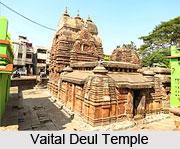 Sishupalgarh
Sishupalgarh
Just two km from the famed Lingaraja Temple of Bhubaneswar lie the ruins of Sisupalgarh. Dating back to the third or fourth century BC, these ruins show that even at that early date there was a well fortified city here, and establish the fact that the Orissan civilization has very ancient roots.
Hirapur
Hirapur has the 11th century Hypaethral temple of sixty four Yoginis. It is second of its kind in Orissa and one of four such unique temples in India.
Atri
Situated amidst greenery and famous for the hot sulphur water spring, Atri, 42 km. from Bhubaneswar and 14 km. from Khurda, is also a holy place with the shrine of Hatakeswar. A bath in the spring water is reputed to cure skin diseases apart from being a pleasant experience.
Ecological Parks of Bhubaneshwar
Biju Patanaik Park Buddha Jayanti Park Ekamra Kanan, Cactus Garden Forest Park, Gandhi Park, I.G. Park, IMFA Park, Kharavela Park, S.P. Mukherjee Park, Subas Bose Park are the eco-parks of Bhubaneshwar.
Visiting Information
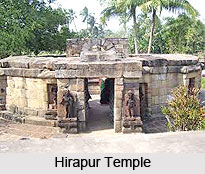 Bhubaneswar is well connected by air, rail and road to the rest of India. The modern Biju Patnaik airport is being extended to receive wide bodied aircraft, and one may well see international charters landing here soon. There are regular Indian Airlines flights to Hyderabad, Nagpur, Calcutta, Delhi, Varanasi, Mumbai and Madras. The airport is very close to town. The Indian Airline office is on Raj Path, by the bus stand.
Bhubaneswar is on the main Kolkata to Madras line so all the main trains stop here. The Howrah-Bangalore mail and Guwahati-Bangalore go to Bangalore. The Coromandel Express is a good train going to Madras. There are direct trains to Delhi, Agra, Remuna, and Varanasi. The Rajdhani Express departs from Delhi one day a week on Friday to Bhubaneswar.
Bhubaneswar is well connected by air, rail and road to the rest of India. The modern Biju Patnaik airport is being extended to receive wide bodied aircraft, and one may well see international charters landing here soon. There are regular Indian Airlines flights to Hyderabad, Nagpur, Calcutta, Delhi, Varanasi, Mumbai and Madras. The airport is very close to town. The Indian Airline office is on Raj Path, by the bus stand.
Bhubaneswar is on the main Kolkata to Madras line so all the main trains stop here. The Howrah-Bangalore mail and Guwahati-Bangalore go to Bangalore. The Coromandel Express is a good train going to Madras. There are direct trains to Delhi, Agra, Remuna, and Varanasi. The Rajdhani Express departs from Delhi one day a week on Friday to Bhubaneswar.



















